The continents lay below
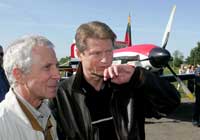
When this publication was under preparation, Rolandas Paksas and Vladimir Makagonov were staying in Yuzno Sakhalinsk, Russia.
The pilots had already made 1/2 of the trip. Here are the details of their route.
June 10, Saturday
9:12 am Rolandas Paksas and Vladimir Makagonov took off from Vilnius S.Darius and S.Girenas aeroclub airfield in Kyviskes. After less than three hours of flight their SM-2000 "Phoenix" landed in Gyor, Hungary. The flight lasted shorter than planned as the wind was favorable. The third member of the crew Austrian Eugen Salpius was waiting for the pilots. E.Salpius is a well known lawyer and his schedule is very busy therefore it is not known yet at what stage of the flight he will join the other two pilots. After the air show the pilots took off heading for the UK.
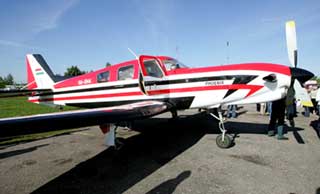 June 11, Sunday
June 11, Sunday
Over the UK the pilots were flying quite low. After the interim landing in Shopdone, by the evening R.Paksas and V.Makagonov had reached Invernesse, Scotland. The airplane and all the systems were working properly.
June 12, Monday
A first really difficult day. About 1000 km to Reykjavik were flown over the Ocean where a cyclone was present. Nearly all the way was an instrumental flight. The flight took place in the clouds as at around 5 km altitude the clouds were still present. Sometimes it was snowing and the landing conditions were not so easy.
June 13, Tuesday
Two long flights in very bad weather conditions. After the first flight the Kangerlussuaqo airfield on the West coast of Greenland was reached. The next flight was shorter and after it, Canada had been reached. The airplane landed in Iqaluit airfield. The total time flown that day: nine hours, five time zones had been crossed.
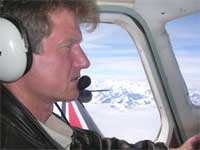
June 14, Wednesday
Two take-offs again this day. Final landing in the evening in Timmins, Ontario.
June 15, Thursday
Some problems entering the USA airspace as it was expected. After crossing the border the pilots had to land in a small airfield near Lake Michigan. After filling the fuel tanks and making the flight documents ready the pilots did not stay here for a night and took off heading for Olathe airfield, Kansas. Here they landed in the dark after five hours of flight.
June 16, Friday
The pilots had to change their route because of the storms in the Southern part of the USA. Successfully avoiding two storms the pilots finally landed in San Antonio, Texas.
June 17, Saturday
Unable to take off because of the fog on the coast of the Mexican Bay.
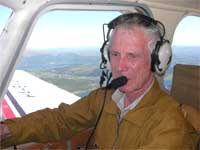 June 18, Sunday
June 18, Sunday
After nearly five and a half hour of flight the SM-2000 "Phoenix" reached Merida on the other side of the Mexican Bay. That was the longest flight to date. 1600 kilometers were flown mostly over water. The maximum height reached - 5100 m.
June 19, Monday
In the darkness the pilots finally reached Panama. 1800 km total distance flown. Taking off from Merida they already knew that they would be unable to reach Panama without a landing because the wind was strong and unfavorable. After the refueling stop they had to fly mostly over water avoiding the storms.
June 20, Tuesday
The equator was crossed on the way to Ecuador. It one of the compulsory rules while flying around the world. Flying in the stormy weather the pilots successfully reached Manta, Ecuador. That is the most Southern point in their journey. In the afternoon they decided to fly to San Chose, the capital of Costa Rico, but because of the bureaucratic interference they had to return back to Manta.
June 21, Wednesday
The pilots successfully reached Costa Rico and after that they flew another 1400 km over Nicaragua, El Salvador and Guatemala and landed in Oaksaca, Mexico. It was a day of two flights of five hours each. No oxygen in the airplane as in the previous airfields there were no possibility to get it supplied. The second flight was a difficult one. The landing in Mexico was difficult too because the airfield is in a mountainous region and because of the storms and rain.
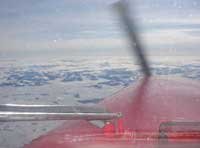 June 22, Thursday
June 22, Thursday
The weather was perfect and the distance flown was one of the biggest. 1850 km were flown over the Mexican coast to the Guaymasa in the Northern Mexico.
June 23, Friday
The pilots entered the US airspace again and landed in San Chose, California. No problems of the kind that were experienced a week ago while flying from Canada.
June 24, Saturday
Back to Canada.

June 25, Sunday
As the pilots are behind in their schedule, they have refused their rest at Abbotsdford, Canada. Having been warmly met by the country's aviators, Rolandas Paksas and Vladimir Makagonov slept at Rone Price's, well-known Airshow Canada President's, home and departed for Alaska.
The first segment, 900 km, up to Prince Rupert. Low clouds had pressed the pilots quite near to the ocean. But in the second part of the route to Alaska (1400 km) they were flying as high as 5 km. Landing at Anchorage. Eight hours in the air.
June 26, Monday
Problems related with the permission to enter the Russian airspace (the same as at the border with the U.S. 10 days ago!) made the pilots to adjust their route. They decided to fly to Nome aerodrome near the Strait of Bering.
June 27-28
After having solved the problem of permission to enter the Russian airspace the pilots overflew the Anadyr. It turned out that some trouble was caused by an elementary mistake: in the flight documents in registration marks HA SMA, which also mean a call, somebody entered G instead of S.
June 29, Thursday
Rolandas Paksas and Vladimir Makagonov were flying by the far border of Russia - 1500 km from Anadyr to Magadan. They had to pilot at the adverse wind almost for six hours. As regards the duration of the flight, it was the longest flight section that had ever been overcome by pilots flying round the globe.
June 30, Friday
On their way to Magadan the pilots landed at Nikolayevsk at the Amour to refill fuel. Later they flew to Khabarovsk, the Far East. We may say that they have already overcome half their route. Congratulations!
July 1, Saturday
Aircraft maintenance performed.
July 2-4
Forced break in Khabarovsk. Japan put in a claim for payment of a large sum for entering their airspace. The pilots' efforts to receive a permission from China were unsuccessful.
July 5, Wednesday
Overflight nearby the border of Japan to Juzhno Sakhalinsk.
July 10
The pilots are in Naha, Okinava, Japan and have a small technical problem. They will continue the flight maybe on Wednesday.
July 14
After a week's delay on the Okinawa Island, Japan, the pilots took off to continue their flight on a 1 600 km route to Manila, the capital of the Philippines. However, after three hours of flight over the Pacific Ocean they became certain that due to a very strong wind it was impossible not only to reach Manila but also the alternative aerodrome. Annoyed, they had to return to Okinawa.
July 15
The wind calmed down slightly, but on their way to Manila the pilots had to land at the Laoag aerodrome for refuelling.
July 17
As bad weather was forecast in the coming days, the pilots were forced to change the route. They decided do depart for Malaysia instead of Australia. First they flew to Puerto Princesa, a city on Palawan Island, Philipinnes. Having refuelled they flew to Kuching, Malaysia.
July 18
Though presently Rolandas Paksas and Vladimir Makagonov are not interested in arithmetics, according to our preliminary estimate that was the day when they met the second condition of their round the world flight: they covered the distance which is equal to the length of Earth's equator (40 075 km). The first condition was met in June when the pilots crossed the equator on their way from Panama to Ecuador.
July 18
Today seems to have been a very special day in respect of flight time (duration) and tension. When flying from Kuching to Pinang, the first route segment in Malaysia, the pilots actually had to fight the storms 5 hours long in the attempt of safe flyby.
They refuelled at Pinang and departed for Bangkok, capital of Thailand, to fly three more hours in stormy weather.
July 19
Rolandas Paksas and Vladimir Makagonov again for eight hours under washed by showers and flung by stormy clouds heavily proceeded from Bangkok, the capital of Thailand, to Calcutta in India (1800 km).
After a flight of more than 6 hours, they landed for re-fuelling in Chittagong (Bangladesh).
The second phase of the flight lasted only 1½ hours, however, the pilots again were tried by buffeting and heavy rain.
July 20
Over 6½ hours the pilots covered a distance from Calcutta in the eastern part of India to Ahmedabad on the other side of the country.
On their way again there was one landing for re-fuelling. Now the pilots had to land in Varanasi airport.
The weather over India varied from storms, rains to clear sky and even mist. The weather conditions were not so threatening as during the last days. The basic advantage of this day was good weather in both aerodromes chosen for landing.
The work of the engine and systems was without problems.
July 21
Two landings in the airport of Muscat, the capital of Oman. Two because on arrival from India to Oman they intended to reach Abu Dhabi in the United Arab Emirates, but after a take-off in Muscat the flight controllers did not like how the transponder functioned in the aircraft SM-2000 and the pilots had to land again after circling for one hour on the approaches to the airport.
One more day of strong impressions. In Ahmedabad the take-off was in a strong rain and the aircraft entered into clouds immediately. Later on approach to the capital of Pakistan Karachi where the landing for re-fuelling was made the pilots sensed breathing of the desert: buffeting of the aircraft was strong.
Further, the flight over the Indian Ocean. If compared with the Pacific, the later met the pilots in a more friendly way: no storms, however, due to poor horizontal visibility the flight was instrumental.
July 22
A short distance from Muscat to Abu Dhabi.

July 23
The pilots made a correction of the route and flying VFR reached Er Ryad, the capital of Saudi Arabia.
July 24
Approximately at 04.00 PM Rolandas Paksas and Vladimir Makagonov reached Egypt and landed in the airport of Sharm El Sheikh.
For nearly 5 hours the pilots flew in the altitude of 3 kilometres according to the visual flight rules. Four hours above the fire breathing multifaceted desert.
July 25
Having said good-bye to Africa, Rolandas Paksas and Vladimir Makagonov returned to the European airspace. After a flight of 4½ hours they reached the island of Crete in the Mediterranean Sea.
After a couple of hours, they took-off from Iraklion airport, turned towards Italy and landed in Pescara airport.
Nine hours of flight, almost 3000 kilometres, such are statistics of the day.
July 26
Rolandas Paksas and Vladimir Makagonov flew from Italy to Gyor, a city in Hungary, where the technical base of a scientific and commercial firm "Technoavia" is located, under good weather conditions.
 July 27
July 27
Having landed at Vilnius aviation club today at 6 p.m., R. Paksas and V. Makagonov connected two farthest points of their round the world flight.
A four-hour flight from Gyor crowned a 47-day deed which demanded not only professional mastery but also extremely good physical health and moral strength of the pilots.
The pilots are going to give a detailed report on the flight later. According to our preliminary estimate, they flew approximately 54,000 km, performed 51 landings, visited 24 countries and flew over the territories of 36 countries.
What the former President of the Republic of Lithuania R. Paksas did first upon landing was to step out on the wing and to raise the Lithuanian flag which travelled round the world.
"We realised that the Earth is small and that everyone has to protect it", he said.

The Pilots and the Aircraft
Rolandas Paksas
Rolandas Paksas was born on 10 June 1956 in Telšiai (Lithuania).
At the age of 16 he made first flights in the glider, however, soon he changed them for aerobatic flights.
He was a member of the Lithuanian national team which became the Champion of the Soviet Union in 1979. In 1980 he won his first gold medal of the Champion of the Soviet Union in the individual event.
As a member of the Soviet Union team he participated in two world championships (1982, 1984).
He was also the leader of the aerobatic formation (Rolandas Paksas, Robertas Noreika, Leonas Jonys) which flew under a bridge above the Neris River on 3 October 2002.
R. Paksas graduated from the Vilnius Engineering and Constructing Institute and the Civil Aviation Academy in Leningrad.
Currently, R. Paksas is the Chairman of the party Order and Justice (liberal democrats). Earlier he was the Mayor of Vilnius (capital of Lithuania), Prime Minister and President of the Republic of Lithuania.
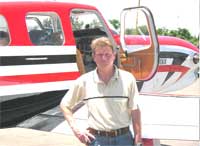
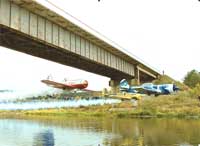
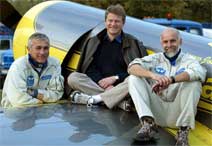

Vladimir Makagonov
Vladimir Makagonov was born in 29 March 1948 in Saint Petersburg (former Leningrad). He graduated from Moscow Institute of Engineering and Physics and wrote a thesis on a subject of aviation and cosmic technologies.
In the study years Vladimir started flying the aerobatic aircraft and more than once participated in sports competitions in Lithuania. It was the time when he established contacts with the Lithuanian pilots.
In 1980 he graduated from the school of the test pilots. For ten years he was employed by the A. Yakovlev Design Bureau. He tested many aircraft from the aerobatic YAK-55 to the liner YAK-42 designed by the Bureau.
At present, he is test pilot of the scientific commercial firm Technoavia.
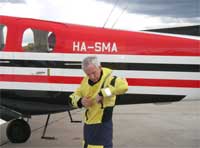

The aircraft SM-2000
The latest aircraft to come from the fertile brain of Slava Kondratiev (Designer of the Yak-55; Sukhoi 26; Finist utility aircraft etc) is the SM-2000. The aircraft is an absolute delight to fly, with powerful controls and very positive handling. Indeed it is fully aerobatic and can loop and roll if a pilot wishes.
The aircraft is transformed by the substitution of the 360-hp/400hp Vedeneyev radial for a Walter M601 F 760-hp turbine. This makes for very impressive STOL performance, while still maintaining high cruising speeds.
The aircraft has now obtained Full International Certification in Hungary, which is now a member of JAR and EASA.
SM-2000 Principal characteristics:
Edmundas Ganusauskas
ganusauskas.e@ans.lt
edmundas.g@cablenet.lt
The pilots had already made 1/2 of the trip. Here are the details of their route.
June 10, Saturday
9:12 am Rolandas Paksas and Vladimir Makagonov took off from Vilnius S.Darius and S.Girenas aeroclub airfield in Kyviskes. After less than three hours of flight their SM-2000 "Phoenix" landed in Gyor, Hungary. The flight lasted shorter than planned as the wind was favorable. The third member of the crew Austrian Eugen Salpius was waiting for the pilots. E.Salpius is a well known lawyer and his schedule is very busy therefore it is not known yet at what stage of the flight he will join the other two pilots. After the air show the pilots took off heading for the UK.
 June 11, Sunday
June 11, SundayOver the UK the pilots were flying quite low. After the interim landing in Shopdone, by the evening R.Paksas and V.Makagonov had reached Invernesse, Scotland. The airplane and all the systems were working properly.
June 12, Monday
A first really difficult day. About 1000 km to Reykjavik were flown over the Ocean where a cyclone was present. Nearly all the way was an instrumental flight. The flight took place in the clouds as at around 5 km altitude the clouds were still present. Sometimes it was snowing and the landing conditions were not so easy.
June 13, Tuesday
Two long flights in very bad weather conditions. After the first flight the Kangerlussuaqo airfield on the West coast of Greenland was reached. The next flight was shorter and after it, Canada had been reached. The airplane landed in Iqaluit airfield. The total time flown that day: nine hours, five time zones had been crossed.

June 14, Wednesday
Two take-offs again this day. Final landing in the evening in Timmins, Ontario.
June 15, Thursday
Some problems entering the USA airspace as it was expected. After crossing the border the pilots had to land in a small airfield near Lake Michigan. After filling the fuel tanks and making the flight documents ready the pilots did not stay here for a night and took off heading for Olathe airfield, Kansas. Here they landed in the dark after five hours of flight.
June 16, Friday
The pilots had to change their route because of the storms in the Southern part of the USA. Successfully avoiding two storms the pilots finally landed in San Antonio, Texas.
June 17, Saturday
Unable to take off because of the fog on the coast of the Mexican Bay.
 June 18, Sunday
June 18, SundayAfter nearly five and a half hour of flight the SM-2000 "Phoenix" reached Merida on the other side of the Mexican Bay. That was the longest flight to date. 1600 kilometers were flown mostly over water. The maximum height reached - 5100 m.
June 19, Monday
In the darkness the pilots finally reached Panama. 1800 km total distance flown. Taking off from Merida they already knew that they would be unable to reach Panama without a landing because the wind was strong and unfavorable. After the refueling stop they had to fly mostly over water avoiding the storms.
June 20, Tuesday
The equator was crossed on the way to Ecuador. It one of the compulsory rules while flying around the world. Flying in the stormy weather the pilots successfully reached Manta, Ecuador. That is the most Southern point in their journey. In the afternoon they decided to fly to San Chose, the capital of Costa Rico, but because of the bureaucratic interference they had to return back to Manta.
June 21, Wednesday
The pilots successfully reached Costa Rico and after that they flew another 1400 km over Nicaragua, El Salvador and Guatemala and landed in Oaksaca, Mexico. It was a day of two flights of five hours each. No oxygen in the airplane as in the previous airfields there were no possibility to get it supplied. The second flight was a difficult one. The landing in Mexico was difficult too because the airfield is in a mountainous region and because of the storms and rain.
 June 22, Thursday
June 22, ThursdayThe weather was perfect and the distance flown was one of the biggest. 1850 km were flown over the Mexican coast to the Guaymasa in the Northern Mexico.
June 23, Friday
The pilots entered the US airspace again and landed in San Chose, California. No problems of the kind that were experienced a week ago while flying from Canada.
June 24, Saturday
Back to Canada.
June 25, Sunday
As the pilots are behind in their schedule, they have refused their rest at Abbotsdford, Canada. Having been warmly met by the country's aviators, Rolandas Paksas and Vladimir Makagonov slept at Rone Price's, well-known Airshow Canada President's, home and departed for Alaska.
The first segment, 900 km, up to Prince Rupert. Low clouds had pressed the pilots quite near to the ocean. But in the second part of the route to Alaska (1400 km) they were flying as high as 5 km. Landing at Anchorage. Eight hours in the air.
June 26, Monday
Problems related with the permission to enter the Russian airspace (the same as at the border with the U.S. 10 days ago!) made the pilots to adjust their route. They decided to fly to Nome aerodrome near the Strait of Bering.
June 27-28
After having solved the problem of permission to enter the Russian airspace the pilots overflew the Anadyr. It turned out that some trouble was caused by an elementary mistake: in the flight documents in registration marks HA SMA, which also mean a call, somebody entered G instead of S.
June 29, Thursday
Rolandas Paksas and Vladimir Makagonov were flying by the far border of Russia - 1500 km from Anadyr to Magadan. They had to pilot at the adverse wind almost for six hours. As regards the duration of the flight, it was the longest flight section that had ever been overcome by pilots flying round the globe.
June 30, Friday
On their way to Magadan the pilots landed at Nikolayevsk at the Amour to refill fuel. Later they flew to Khabarovsk, the Far East. We may say that they have already overcome half their route. Congratulations!
July 1, Saturday
Aircraft maintenance performed.
July 2-4
Forced break in Khabarovsk. Japan put in a claim for payment of a large sum for entering their airspace. The pilots' efforts to receive a permission from China were unsuccessful.
July 5, Wednesday
Overflight nearby the border of Japan to Juzhno Sakhalinsk.
July 10
The pilots are in Naha, Okinava, Japan and have a small technical problem. They will continue the flight maybe on Wednesday.
July 14
After a week's delay on the Okinawa Island, Japan, the pilots took off to continue their flight on a 1 600 km route to Manila, the capital of the Philippines. However, after three hours of flight over the Pacific Ocean they became certain that due to a very strong wind it was impossible not only to reach Manila but also the alternative aerodrome. Annoyed, they had to return to Okinawa.
July 15
The wind calmed down slightly, but on their way to Manila the pilots had to land at the Laoag aerodrome for refuelling.
July 17
As bad weather was forecast in the coming days, the pilots were forced to change the route. They decided do depart for Malaysia instead of Australia. First they flew to Puerto Princesa, a city on Palawan Island, Philipinnes. Having refuelled they flew to Kuching, Malaysia.
July 18
Though presently Rolandas Paksas and Vladimir Makagonov are not interested in arithmetics, according to our preliminary estimate that was the day when they met the second condition of their round the world flight: they covered the distance which is equal to the length of Earth's equator (40 075 km). The first condition was met in June when the pilots crossed the equator on their way from Panama to Ecuador.
July 18
Today seems to have been a very special day in respect of flight time (duration) and tension. When flying from Kuching to Pinang, the first route segment in Malaysia, the pilots actually had to fight the storms 5 hours long in the attempt of safe flyby.
They refuelled at Pinang and departed for Bangkok, capital of Thailand, to fly three more hours in stormy weather.
July 19
Rolandas Paksas and Vladimir Makagonov again for eight hours under washed by showers and flung by stormy clouds heavily proceeded from Bangkok, the capital of Thailand, to Calcutta in India (1800 km).
After a flight of more than 6 hours, they landed for re-fuelling in Chittagong (Bangladesh).
The second phase of the flight lasted only 1½ hours, however, the pilots again were tried by buffeting and heavy rain.
July 20
Over 6½ hours the pilots covered a distance from Calcutta in the eastern part of India to Ahmedabad on the other side of the country.
On their way again there was one landing for re-fuelling. Now the pilots had to land in Varanasi airport.
The weather over India varied from storms, rains to clear sky and even mist. The weather conditions were not so threatening as during the last days. The basic advantage of this day was good weather in both aerodromes chosen for landing.
The work of the engine and systems was without problems.
July 21
Two landings in the airport of Muscat, the capital of Oman. Two because on arrival from India to Oman they intended to reach Abu Dhabi in the United Arab Emirates, but after a take-off in Muscat the flight controllers did not like how the transponder functioned in the aircraft SM-2000 and the pilots had to land again after circling for one hour on the approaches to the airport.
One more day of strong impressions. In Ahmedabad the take-off was in a strong rain and the aircraft entered into clouds immediately. Later on approach to the capital of Pakistan Karachi where the landing for re-fuelling was made the pilots sensed breathing of the desert: buffeting of the aircraft was strong.
Further, the flight over the Indian Ocean. If compared with the Pacific, the later met the pilots in a more friendly way: no storms, however, due to poor horizontal visibility the flight was instrumental.
July 22
A short distance from Muscat to Abu Dhabi.
July 23
The pilots made a correction of the route and flying VFR reached Er Ryad, the capital of Saudi Arabia.
July 24
Approximately at 04.00 PM Rolandas Paksas and Vladimir Makagonov reached Egypt and landed in the airport of Sharm El Sheikh.
For nearly 5 hours the pilots flew in the altitude of 3 kilometres according to the visual flight rules. Four hours above the fire breathing multifaceted desert.
July 25
Having said good-bye to Africa, Rolandas Paksas and Vladimir Makagonov returned to the European airspace. After a flight of 4½ hours they reached the island of Crete in the Mediterranean Sea.
After a couple of hours, they took-off from Iraklion airport, turned towards Italy and landed in Pescara airport.
Nine hours of flight, almost 3000 kilometres, such are statistics of the day.
July 26
Rolandas Paksas and Vladimir Makagonov flew from Italy to Gyor, a city in Hungary, where the technical base of a scientific and commercial firm "Technoavia" is located, under good weather conditions.
 July 27
July 27 Having landed at Vilnius aviation club today at 6 p.m., R. Paksas and V. Makagonov connected two farthest points of their round the world flight.
A four-hour flight from Gyor crowned a 47-day deed which demanded not only professional mastery but also extremely good physical health and moral strength of the pilots.
The pilots are going to give a detailed report on the flight later. According to our preliminary estimate, they flew approximately 54,000 km, performed 51 landings, visited 24 countries and flew over the territories of 36 countries.
What the former President of the Republic of Lithuania R. Paksas did first upon landing was to step out on the wing and to raise the Lithuanian flag which travelled round the world.
"We realised that the Earth is small and that everyone has to protect it", he said.
The Pilots and the Aircraft
Rolandas Paksas
Rolandas Paksas was born on 10 June 1956 in Telšiai (Lithuania).
At the age of 16 he made first flights in the glider, however, soon he changed them for aerobatic flights.
He was a member of the Lithuanian national team which became the Champion of the Soviet Union in 1979. In 1980 he won his first gold medal of the Champion of the Soviet Union in the individual event.
As a member of the Soviet Union team he participated in two world championships (1982, 1984).
He was also the leader of the aerobatic formation (Rolandas Paksas, Robertas Noreika, Leonas Jonys) which flew under a bridge above the Neris River on 3 October 2002.
R. Paksas graduated from the Vilnius Engineering and Constructing Institute and the Civil Aviation Academy in Leningrad.
Currently, R. Paksas is the Chairman of the party Order and Justice (liberal democrats). Earlier he was the Mayor of Vilnius (capital of Lithuania), Prime Minister and President of the Republic of Lithuania.



Vladimir Makagonov
Vladimir Makagonov was born in 29 March 1948 in Saint Petersburg (former Leningrad). He graduated from Moscow Institute of Engineering and Physics and wrote a thesis on a subject of aviation and cosmic technologies.
In the study years Vladimir started flying the aerobatic aircraft and more than once participated in sports competitions in Lithuania. It was the time when he established contacts with the Lithuanian pilots.
In 1980 he graduated from the school of the test pilots. For ten years he was employed by the A. Yakovlev Design Bureau. He tested many aircraft from the aerobatic YAK-55 to the liner YAK-42 designed by the Bureau.
At present, he is test pilot of the scientific commercial firm Technoavia.

The aircraft SM-2000
The latest aircraft to come from the fertile brain of Slava Kondratiev (Designer of the Yak-55; Sukhoi 26; Finist utility aircraft etc) is the SM-2000. The aircraft is an absolute delight to fly, with powerful controls and very positive handling. Indeed it is fully aerobatic and can loop and roll if a pilot wishes.
The aircraft is transformed by the substitution of the 360-hp/400hp Vedeneyev radial for a Walter M601 F 760-hp turbine. This makes for very impressive STOL performance, while still maintaining high cruising speeds.
The aircraft has now obtained Full International Certification in Hungary, which is now a member of JAR and EASA.
SM-2000 Principal characteristics:
- Empty weight 1468kgs
- Maximum take off weight 2500kgs
- Maximum fuel capacity 840 litres
- Accommodation, pilot plus 4 plus baggage
- Max cruising speed 390km/hr
- Economical cruising speed 300km/hr
- Range at maximum cruising speed at 6000m - 2000km
- Range at maximum cruising speed at 3000m - 1500km
- Maximum range at 3,000m - 2,000km
- Stalling speed (with flaps) 111km/hr
- Take off run at MTOW 330m
- Landing run at MTOW 400m
- Rate of climb at MTOW 10m per second

Edmundas Ganusauskas
ganusauskas.e@ans.lt
edmundas.g@cablenet.lt
Ed: Many thanks to Edmundas Ganusauskas for the Flight and Pilots details.